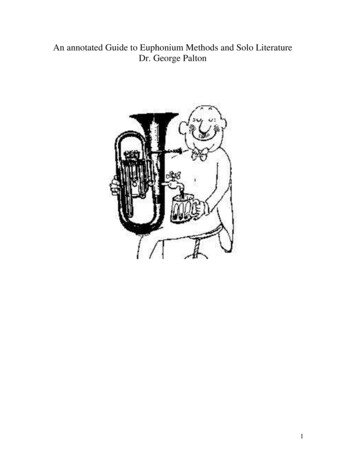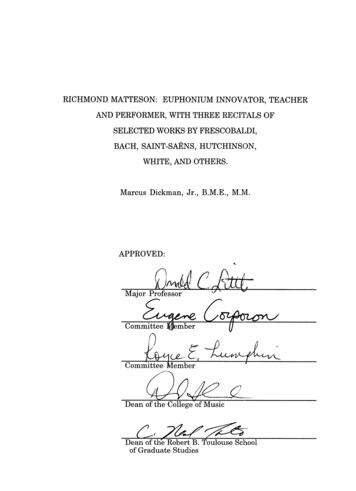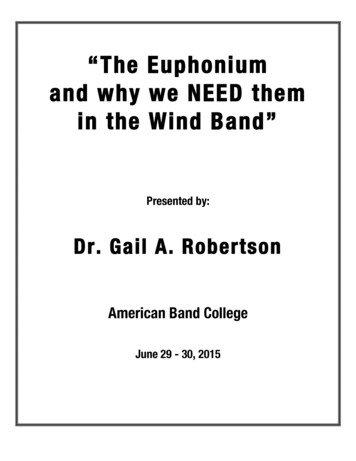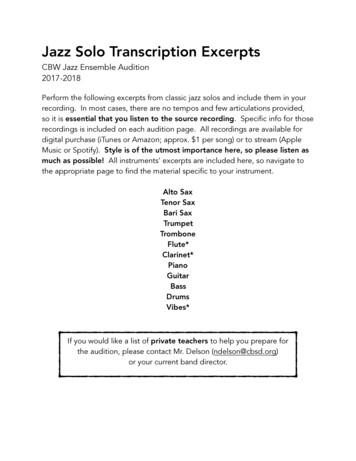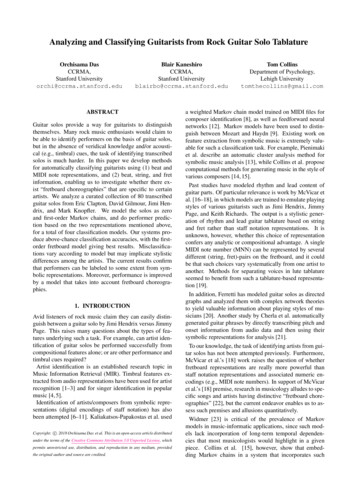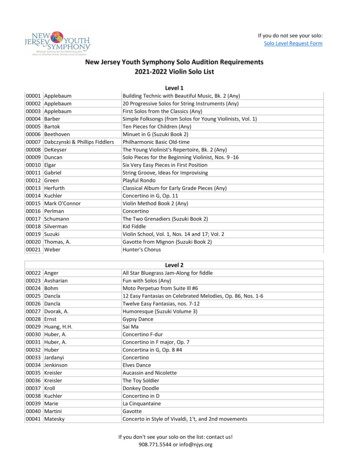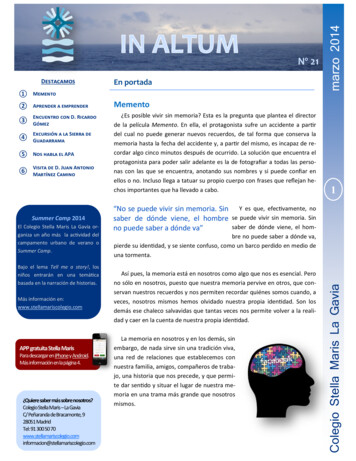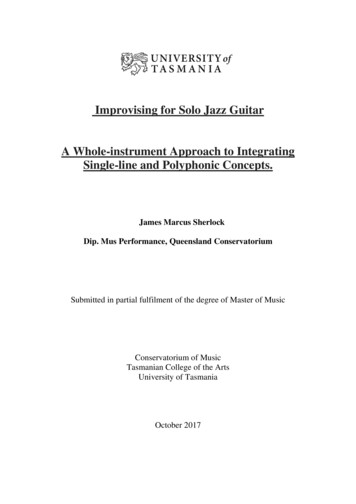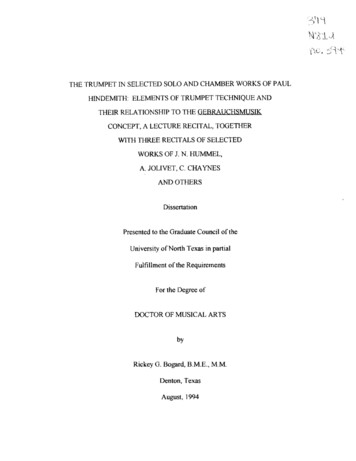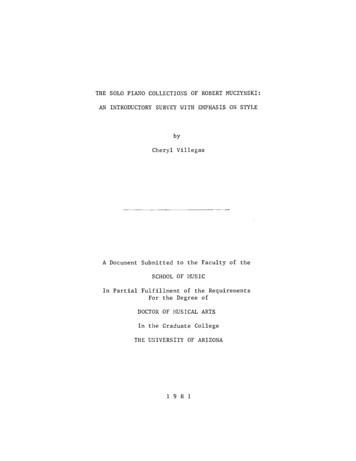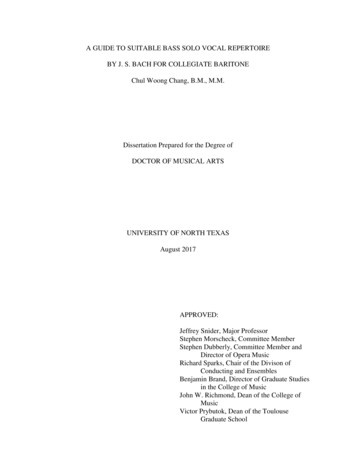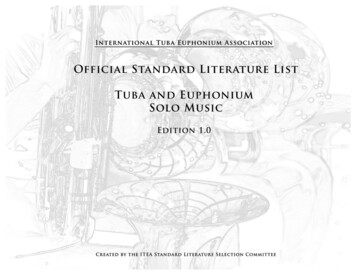
Transcription
EUPHONIUM SOLO MUSICCREATED BY THE ITEA STANDARD LITERATURE SELECTION COMMITTEE
TABLE OF CONTENTSPAGE ITEA Standard Literature Selection Committee3 Criteria for Determining Standard Works4 Rating System5 Euphonium Rating Rubric7 Tuba Rating Rubric9 Piano Rating System11 Euphonium Solo List12 Euphonium Solo Collection Abbreviation Key43 Tuba Solo List44 Tuba Solo Collection Abbreviation Key792CREATED BY THE ITEA STANDARD LITERATURE SELECTION COMMITTEE
ITEA STANDARD LITERATURE SELECTION COMMITTEEDr. Mark S. Cox, chair Professor of Tuba and Euphonium, Central Michigan UniversityTuba and Euphonium Solo ListsDr. Mark Carlson Associate Professor of Music, Mount St. Mary’s UniversityEuphonium Solo ListDr. Mary Jo CoxDr. Matthew Mireles Collaborative Artist: Falcone Festival; ITEC; IWBC, MWRTECPiano ratings: Tuba and Euphonium Solo Lists Assistant Professor, Director of Bands and Low Brass, Cameron UniversityEuphonium Solo ListDr. Seth FletcherDr. Jesse Orth Low Brass Artist and Educator; www.EuphoniumUnlimited.comEuphonium Solo List Instructor of Tuba and Euphonium, University of Northern IowaTuba and Euphonium Solo ListsDrew JonesDr. Joel Pugh Undergraduate Tuba Performance and Music Education Major, CMUAssistant to the Chair Instructor of Low Brass, University of North DakotaEuphonium Solo ListDr. Jamie LiptonPatty Welch Associate Professor of Low Brass, Henderson State UniversityEuphonium Solo List Music Education – Grades 7-12 West Irondequoit Central School DistrictTuba and Euphonium Solo ListsDr. Steven Maxwell Associate Professor of Tuba and Euphonium, Kansas State UniversityTuba and Euphonium Solo Lists3CREATED BY THE ITEA STANDARD LITERATURE SELECTION COMMITTEE
CRITERIA FOR DETERMINING STANDARD WORKSDesigned and created by Dr. Mark S. CoxAll three (3) criteria in the “Absolute Requirements” section must apply to the music.Once these criteria have been met, then at least three (3) criteria from the “Additional Requirements” section must be selected before the work can beconsidered a standard work.Absolute Requirements:1.2.3.Does the music enhance and/or promote the advancement of the tuba or euphonium?Does the music promote the highest level of artistry for the tuba or euphonium?Does the music inspire further study or interest in the euphonium or tuba?Additional Requirements(minimum of three are required)1.2.3.4.5.6.Is the music originally written for the tuba or euphonium?Does the music have strong pedagogical value?Has the music been professionally recorded?Has the music received numerous public performances?Does the music appear on numerous professional repertoire lists?Does the music appear on numerous national, state, or regional “Solo and Ensemble” required or recommended performance lists?4CREATED BY THE ITEA STANDARD LITERATURE SELECTION COMMITTEE
RATING SYSTEMDesigned and created by Dr. Mark S. CoxOVERVIEW“Range” (40 points) is the most basic and critical element in choosing repertoire. Thus, it carries the most weight. The difficulty and types ofintervals is the next factor in determining how challenging a work will be for a student. A soloist’s ability to navigate these intervals (what thecommittee termed “Dexterity” [30 points]) has a profound impact on how successful the performance will be. “Rhythm and Tempo” is self-explanatoryand carries a numeric value of 20 points, realizing that there is often room for variation in tempo, depending on interpretation. Finally, “Miscellaneous”(10 points) includes items that are found in more advanced works that create additional challenges.TUBA RANGE (40 POINTS MAXIMUM)The basic tuba range (used consistently in early and intermediate works) extends from low B-flat to D in the staff. Within this basic range, thehighest and lowest notes are determined and each half-step within the range receives one (1) point. Thus, a piece utilizing a range of a major third (B-flatto D, e.g.) would receive a number rating of 4. If the range of a work encompassed an octave, then it would receive a rating of 12. As would be expected,as range is extended, the level of difficulty increases. High range is more difficult to master than low range for most students, and the numerical valuesreflect this. Whenever a solo goes below or above the basic range as defined above, the starting numerical value is 16. Points are then added to thisdefault number according to the chart. For example, a work that goes up to a D above middle C would receive 4 extra points. The total for the rangewould be 20 (16 4 20). A work that goes down to a low F would receive 6 extra points. The total would be 22 (16 6 22). If the range extends above andbelow the “basic range,” both values are added to the 16 default points. For example, a work with a range of low F to B-flat below middle C wouldreceive 25 points (16 6 3 25). If the total surpasses the maximum, it automatically defaults to 40.EUPHONIUM RANGE (40 POINTS MAXIMUM)Points for range are more evenly distributed, although the low range is weighted somewhat more heavily than the high range. The basic rangeextends from B-flat to D above middle C. As above, when pieces go higher than the basic range, points are added according to the chart to the defaultnumber of 16. Pieces that extend lower than the basic range use either the “A” or “B” section of the chart, depending on whether the work requires fourvalves or not. For example a solo with the range of C below the staff to G above middle C would total 29 points (16 [basic] 9 [low “B “ chart] 4 [highchart] 29). If the combined elements, added together, surpasses the maximum, the total automatically defaults to 40DEXTERITY, RHYTHM AND TEMPO, MISCELLANEOUSThese become necessarily more subjective. The characteristics and point values are the same for both instruments.DEXTERITY (30 POINTS MAXIMUM)The most challenging interval (taking into consideration frequency and context) is used as the basis for awarding points. For example, if a piececontains primarily major thirds with one perfect fifth, the major third would be used as the primary interval (4 points). Additional points may be addedfor pieces that require medium or advanced dexterity in moving from note to note. Tempo, rhythms, and the composer’s style and writing all have thepotential to affect this.5CREATED BY THE ITEA STANDARD LITERATURE SELECTION COMMITTEE
RHYTHM AND TEMPO (20 POINTS MAXIMUM)In most (although not all) solos, rhythms can be narrowed down to a few that most consistently make up the fabric of the piece. The ratings aredetermined by choosing the two rhythmic elements that most characterize the piece. Easiest works will be characterized by the type of note, while moreadvanced pieces will more often be defined by rhythmic concepts (syncopation, jazz, e.g.). Additional points for medium or fast tempi are added toreach the final total. A beginner solo might use only quarter and half notes. If the tempo was slow, total points would be 3 (1 2 3). A more advancedsolo might look like this: 32 notes, syncopation, and fast tempo adds up to 16 (7 3 6 16). Note that points are capped at 20. If the individualelements added together surpass this, the total automatically defaults to 20.ndMISCELLANEOUS (10 POINTS MAXIMUM)This includes compositional techniques and details that increase the difficulty of the work. Pick as many as are applicable. Miscellaneous pointsare capped at 10. If the individual elements surpass this, the total automatically defaults to 10. These are advanced techniques; most beginner andintermediate pieces will not contain anything from this list.OPTIONAL NOTE(S) RATINGComposers and/or publishers at times add “optional ” notes for tuba and euphonium players, usually up or down an octave. This can add amore bravura element to the music, or, conversely, provides an easier alternative to a challenging passage. When this occurs, the rating inclusive of theoptional notes can be found under the header “Optional.” The ratings for the individual categories in which the notes occur are represented by thelower of the two numbers.6CREATED BY THE ITEA STANDARD LITERATURE SELECTION COMMITTEE
EUPHONIUM7CREATED BY THE ITEA STANDARD LITERATURE SELECTION COMMITTEE
Euphonium Solo Ratings (cont.)No. 2 - DEXTERITYNo. 3 - RHYTHM and TEMPONo. 4 - MISCELLANEOUS30 points maximum20 points maximum10 points maximumFIRST: Select the most difficult or influentialinterval. THEN: ADD additional points for thedifficulty.Ex: M6 ( 9) and Med. Dex ( 7) 16FIRST: Select TWO RHYTHMS that characterizethe piece of music and add them together.Select as many compositional techniques as applicable. If thenumber surpasses 10 points, then assign the maximum points 10.Ex: Quarters/Eighths ( 3) and 16th ( 7) 10THEN: Choose"Additional Points - Tempo."Ex: Fast Tempo ( 6) pointsADD the TWO scores together: 10 6 16 (finalrating). If the number surpasses 20 points, thenassign the maximum points 20.BYPOINTS BY INTERVALSTEP1/2 Step 1m21 Step 2M21 1/2 Steps 3m32 Steps 4M32 1/2 Steps 5P43 Steps 6A4/D53 1/2 Steps 7P54 Steps 8m64 1/2 Steps 9M65 Steps 10m75 1/2 Steps 11M76 Steps 12P8/Octave6 1/2 Steps 13m97 Steps 14M97 1/2 Steps 15m108 Steps 16M10ADDITIONAL POINTS- Easy dexterity: add 0 points- Medium dexterity: add 7 Points- Advanced dexterity: add 14 PointsPART 1 - PRIMARY RYHTHMWhole, Dotted Half or Half NotesQuarter or 8th NotesDotted 8th/16th Note Pattern16th Notes or GreaterSyncopationTriplets or Compound MeterJazz RhythmsComplex RhythmsPOINTSMISC. COMPOSITIONAL TECHNIQUESPOINTS135733410Multiple Key ChangesMultiple Time ChangesExcessive Length of PhrasesDifficult KeyMuteClef ChangesMultiple (excessive) Dynamic ChangesChromaticismMultiple Tempo ChangesExcessive Endurance RequiredOrnamentation (trills, grace notes, etc.)Non-idomatic writing "hard for hard sake"Special Techniques (lip trills, multiphonics, etc.)Advanced Compositional Techniques(combination of multiple items from list above)111112222334610ADDITIONAL POINTS - TEMPOSlow0Medium2Fast68CREATED BY THE ITEA STANDARD LITERATURE SELECTION COMMITTEE
TUBA9CREATED BY THE ITEA STANDARD LITERATURE SELECTION COMMITTEE
Tuba Solo Ratings (cont.)No. 2 - DEXTERITYNo. 3 - RHYTHM and TEMPONo. 4 - MISCELLANEOUS30 points maximum20 points maximum10 points maximumFIRST: Select the most difficult or influentialinterval. THEN: ADD additional points for thedifficulty.Ex: M6 ( 9) and Med. Dex ( 7) 16FIRST: Select TWO RHYTHMS that characterizethe piece of music and add them together.Select as many compositional techniques as applicable. If thenumber surpasses 10 points, then assign the maximum points 10.Ex: Quarters/Eighths ( 3) and 16th ( 7) 10THEN: Choose"Additional Points - Tempo."Ex: Fast Tempo ( 6) pointsADD the TWO scores together: 10 6 16 (finalrating). If the number surpasses 20 points, thenassign the maximum points 20.BYPOINTS BY INTERVALSTEP1/2 Step 1m21 Step 2M21 1/2 Steps 3m32 Steps 4M32 1/2 Steps 5P43 Steps 6A4/D53 1/2 Steps 7P54 Steps 8m64 1/2 Steps 9M65 Steps 10m75 1/2 Steps 11M76 Steps 12P8/Octave6 1/2 Steps 13m97 Steps 14M97 1/2 Steps 15m108 Steps 16M10PART 1 - PRIMARY RYHTHMADDITIONAL POINTS- Easy dexterity: add 0 points- Medium dexterity: add 7 Points- Advanced dexterity: add 14 PointsWhole, Dotted Half or Half NotesQuarter or 8th NotesDotted 8th/16th Note Pattern16th Notes or GreaterSyncopationTriplets or Compound MeterJazz RhythmsComplex RhythmsPOINTSMISC. COMPOSITIONAL TECHNIQUESPOINTS135733410Multiple Key ChangesMultiple Time ChangesExcessive Length of PhrasesDifficult KeyMuteClef ChangesMultiple (excessive) Dynamic ChangesChromaticismMultiple Tempo ChangesExcessive Endurance RequiredOrnamentation (trills, grace notes, etc.)Non-idomatic writing "hard for hard sake"Special Techniques (lip trills, multiphonics, etc.)Advanced Compositional Techniques(combination of multiple items from list above)111112222334610ADDITIONAL POINTS - TEMPOSlow0Medium2Fast610CREATED BY THE ITEA STANDARD LITERATURE SELECTION COMMITTEE
CRITERIA FOR DETERMINING PIANO RATINGSDr. Mary Jo CoxWorking together with a pianist should be a rewarding experience. A good pianist helps to make the music come alive and provides both support andinspiration for the soloist. Recognizing that it would be helpful for both teachers and soloists to know the level of difficulty of the piano part whenchoosing music, piano parts have been rated and divided into three categories: Easy, Medium, and Difficult. “Easy” piano parts should be able to beperformed by anyone with basic piano competency; these pieces are sight-readable by advanced pianists. Those pieces in the “Medium” categorypresent more technical challenges and require more facility. “Difficult” pieces present challenges that require advanced technique and musicianship.Many factors were taken into consideration during the ratings process. The main characteristics that resulted in inclusion in each category are presentedbelow.EASY Mainly homophonic textures Limited chromaticism/primarily diatonic writing More complicated voicing and textures occur only in very slow tempi Few challenges in putting together piano and solo partsMEDIUM Octaves, leaps, or passage work that requires a stronger technique Frequent chromaticism An "easy" piece with non-idiomatic or awkward writing may be categorized as "medium" Moderate challenges in putting together piano and solo partsDIFFICULT Advanced technique required for octave passages, repeated notes or chords, passage work Extreme chromaticism Coordination between pianist and soloist is challenging Demands a high level of interpretation and musicianship Awkward or non-idiomatic piano writing Extended piano techniquesPIANO RATING KEY E Easy M Medium D Difficult U Unaccompanied NA Not Applicable (there is no piano part available; may be scored for other instruments)11CREATED BY THE ITEA STANDARD LITERATURE SELECTION COMMITTEE
EUPHONIUM SOLO MUSICTw
Euphonium Solo List Dr. Jesse Orth Instructor of Tuba and Euphonium, University of Northern Iowa Tuba and Euphonium Solo Lists Dr. Joel Pugh Instructor of Low Brass, University of North Dakota Euphonium Solo List Patty Welch Music Education – Grades 7-12 West Irondequoit Central School District Tuba and Euphonium Solo Lists
